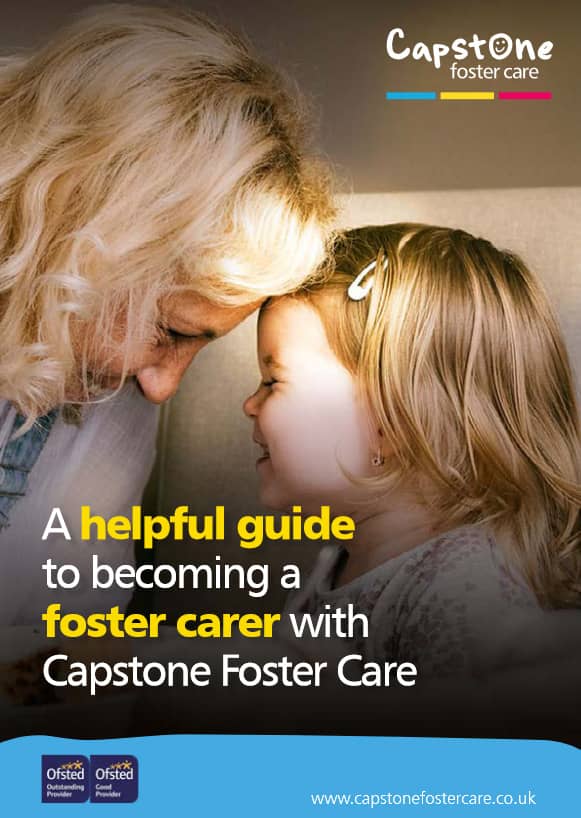


Fostering a disabled child
The role of an independent fostering agency
How to choose a foster care agency
Can I choose who I foster?
What are the benefits of fostering with an independent fostering agency?
What happens when a child is taken into care?
Fostering process: what happens on an initial home visit?
Fostering with local authority vs independent agency
A complete guide to becoming a foster carer
How Are Children in Foster Care Matched with Carers?
Foster Care Budgeting Tips
Becoming A Foster Carer
What is a Care Leaver?
What is a Foster Carer?
Fostering Regulations
How long does it take to become a Foster Carer?
What are the Foster Care requirements?
Changing IFA - Transferring to Capstone
8 reasons why a child may be taken into care
Fostering as a Career
Can you foster if you smoke or vape?
A guide to fostering assessments
LGBTQ+ Fostering
Equality, Inclusion & Anti-discriminatory Practice in Foster Care
What can disqualify you from foster care?
Can you foster if you’re on benefits?
Top transferable job skills to become a foster carer
Fostering as a same sex couple
Fostering while renting
Can you foster if you have mental health issues?
Is there an age limit for fostering in the UK?
Do foster carers get a pension?
How to foster a child: A step by step guide
How do DBS Checks Work?
Can I foster if...?
Mythbusting the top 10 Foster Care Myths
Can I foster if I am disabled?
LGBT Fostering Mythbusting
Can I foster if I have pets?
Can I Foster A Child?
Can I Foster and Work?
Can you Foster with a Criminal Record
Can Single People Foster?
LGBT Family and Foster Care
Fostering across Cultures
Muslim Fostering
Christian Foster Care
Sikh Fostering
Empty Nest Syndrome and Foster Care
Can I Foster?
Fostering Babies and Young Children
What is Kinship Care?
Fostering Babies - Myths
Focusing on Parent & Child Fostering
Fostering Siblings
Fostering Teenagers
Fostering Teenagers - Breaking down the Myths
Fostering Unaccompanied and Asylum Seeking Children
Mother and Baby Foster Placements
Private Fostering
How does therapeutic fostering work?
Young Children Fostering Placements
Difference between short and long-term fostering
Reunification and Birth Parents: A Guide for Foster Carers
What is an EHC Plan? A Guide for Foster Carers
How to prepare a child for becoming a care leaver
Children who foster: impact of fostering on birth children
Fostering LGBTQ+ Youth
How to prepare your home for a foster child
How to help a lonely child: A Guide for Foster Carers
What are the National Minimum Standards for Fostering Services?
10 tips for foster children's education
How to prepare your foster child for secondary school
Tips for coping when foster placements end
Tips for foster parents during Coronavirus
What happens if foster parents get divorced?
5 ways to manage Mother's Day with foster children
Tips for managing foster children's bedtime routines
How to handle foster child bullying
Fostering allowances and the gender pay gap
What discounts can foster carers get?
How to adopt from Foster Care
5 ways to manage Father's Day for children in foster care
8 most common fostering challenges
FosterTalk Membership with Capstone Foster Care
Supporting foster children's contact with birth families
A guide to independent fostering
Keeping Children Safe Online: A Guide For Foster Carers
Movies About Foster Care
Play-based learning strategies for foster carers
A Guide to the Staying Put Program
How to deal with empty nest syndrome
How to recognise signs of depression in foster children
Can you take a foster child on holiday?
Tips and advice on fostering with a disability
10 tips on connecting with your Foster Child
Fostering vs Adoption - What's the difference?
How Fostering can change a future
How to adopt from Foster Care
How to encourage children to read in Foster Care
How to prepare a Foster Child's bedroom
Reading and Storytelling with Babies and Young Children
Supporting Children's Learning
The 20 most recommended books Foster Carers and young people should read
Things you can do when your children leave home
The impact of early childhood traumas on adolescence and adulthood
Anxious Disorders in Foster Children
What is sexual abuse and sexual violence
Foster Child behaviour management strategies
Foster Parent Advice: What to expect in your first year of fostering
Capstone's twelve tips at Christmas
10 celebrities who grew up in Foster Care
Could Millenials be the solution to the Foster Care crisis?
Do you work in Emergency Services?
Form F Assessor and Assessment Training
Foster Care Fortnight
Improving Children's Welfare - Celebrating Universal Children's Day
New Year - New Career - Become a Foster Carer
Young People Charities
Before going into the reasons why, let’s take a look at some of the recent statistics from the UK government regarding fostering.
The 2017 statistics are still being compiled so the report on the numbers from April 1 2016 to March 31 2017 is not yet available. We can take a peek at the numbers for the previous year, which are a reasonably accurate representation of the current status.
During the year ending 31 March 2016, there was a one-third drop in the number of applications to be foster carers. The year ending 31 March 2015 had 16,920 applications. Last year, there were only 11,460 applications. There were fewer carers at 31 March 2016 and the majority were white. More carers from minority ethnic groups were approved to foster, mostly by independent fostering agencies rather than by local authorities.
Of the long-term foster carers, 84% were white (very similar to the year before which had 85% white foster carers). In March 2016, 9 local authorities had no long-term foster carers from minority ethnic groups although these same local authorities did have minority ethnic children in their care
Again, using figures from 2016, 77% of the children in care were white and 22% were from minority ethnic groups. (That adds up to 99%. Some children in care were listed without any reference to their ethnicity.) The figures were very much the same for 2015. According to the Department for Education, 24% of all looked after children are from minority ethnic groups. As a side note, 21% of children in England are from minority ethic groups, according to the 2011 census.
The British Association for Adoption and Fostering (BAAF) provided this information on looked after children on 31 March 2017. There were 72,670 children in the care of local authorities, a figure which translates to 62 per 10,000 children under 18 being in care.
A snapshot on 31 March 2017 reveals that 74% (53,420) were living with foster carers. Where were the other 26%? 11% were in secure units, children’s homes or hostels, 6% were placed with their parents, 3% were placed for adoption, 4% were with another placement in the community, and 2% were placed in residential schools or other residential settings.
Working with these figures, it is easy to see that there is a good chance that black and minority ethnic (BME) children will not be placed in a home that matches their own culture.
Community Care Inform and BAAF conducted a study in 2011 and produced guidance requiring “foster carers and fostering services to ensure full attention is paid to a looked-after child’s gender, faith, ethnic origin, cultural and linguistic background, sexual orientation and any disability they might have. Children should be encouraged and supported to have positive views of themselves and to be proud of their identity and heritage…”
In other words, having a foster carer who is Muslim is beneficial for Muslim children in care. At the very least they need homes where their religious practice is supported and respected. Celebrating their ethnic holidays and traditions maintains a cultural continuity for them.
This is not a notion that has just recently emerged. In the Community Care Inform and BAAF‘s study, it was stated that as far back as “the 1970s, 1980s and 1990s, studies found the placement of black children in black families promoted the development of identity and a positive sense of self.”
Referring to a 2006 study, it was also noted that looked after children “are vulnerable to negative impacts on their identity formation, resulting from interrupted attachments. Black and minority ethnic children are additionally at risk of disruption of contact with their ethnic group of origin.”
Beyond the disruption of contact, there can be other concerns that grow out of not having cultural consistency within foster homes for BME children and young people. As experienced and as well-trained in cross-culture traditions as a foster carer can be and as loving as they can be, there are two sides to the concept of fostering across cultures.
Here’s an example of the type of situation that can emerge:
Suppose a BME child is in a trans-racial placement where the foster parents are white. The child is treated very well by the white foster carers and feels safe, loved, and cared for in the placement. Then the child is returned to his or her own family, which is not white. Back with their own family and familiar environment, the child is confronted with the response of their own cultural community.
This can be problematic. Somehow having been placed in a home that is of a different culture, even if the foster family promotes cultural understanding, can set the children apart as “different” when they return to their own home. Because they have been living outside of their own culture for a period of time, their ethnicity may be considered diluted.
The more ethnically and culturally similar placement families are to the foster child’s own family, the better it is for the child who is then able to continue living in the culture, religion, and language of his or her heritage without disruption.
There is also the very important matter of the pressures that can be perceived by a BME family that is not perceived in a white family – racism and discrimination. Being in a foster family that deeply grasps the impact of racism and discrimination is something that needs to be accepted when it comes to fostering.
All the training in the world is incapable of reaching into the bone-deep effect of being part of a cultural minority. Being a foster carer involves having many personal qualities. The child must feel accepted and loved and safe. Foster parents carry this out to the greatest extent possible. The more closely the foster environment matches the culture of the child’s own home, the more the foster parent is able to meet the deepest needs of the child.
The Community Care Inform and BAAF study made a point that is illuminating. The children also need to be heard. They have been overlooked in discussions about their permanent placement needs. The study noted, “A key task for foster carers becomes helping a child or young person to understand and feel positive about their racial identity.”
It is clear that more culturally diverse foster parents are needed. There are some essential requirements for entering into this incredibly satisfying career. There is a hierarchy of needs. What does a foster parent need to have to be able to meet the basic needs?
Some are external requirements such as having the space for a foster child. Each child over the age of 3 is expected to have their own bedroom unless they are siblings in which case two can share a bedroom but each would have his or her own bed.
Your lifestyle status is more flexible. You can be straight or LGBT, single or married, a homeowner or a renter. However, you should be over 21 years old and able to pass a Disclosure and Barring Service check (DBS) and a health check.
Your personal characteristics should feature patience, compassion, strong communication skills, flexibility, and energy.
Fostering is a delicate balancing act. Here is a scenario. It is 10 o’clock at night. The local authority is called about a situation. A frightened and exhausted child must be taken into care as there is a violent fight taking place in the child’s home. The police are involved and the dynamics of the violence need to be assessed.
The child is whisked away by a social worker and a committee of experts analyse the situation and reach out to an independent fostering agency for a placement as quickly as one can be found. By quickly, it means that a placement must be found within hours.
Under a time constraint, the placement committee must assess the foster home possibilities while taking with it the following qualifications in the equation:
Now, add in the cultural factor, the child is from a Muslim cultural background. You have several BME foster homes but they are occupied. There are five homes with white British non-muslim families with space available right now.
The social worker checks to see which of the available foster homes have had extensive training in trans-racial placements. You find one but it is not a family equipped for caring for a child in a wheelchair, either structurally or experientially.
This is just an off-the-cuff scenario. There are rarely simple solutions when a child needs foster care and needs it now. An emergency placement can act as a placeholder until a longer term one can be found. This can be stressful for the looked after child, who is taken from their home, given a bed for a night and moved the next day.
When it comes to finding a calm, secure, and immediate placement, sometimes compromises have to be made.
There is a shortage of foster carers in general and in areas with a rich mosaic of ethnicities, cultures, and religions, there is a particular demand for people who are able to assume the gratifying job of fostering. Across the UK, there is an increasing demand for foster carers, especially from our country’s diverse range of cultures.
It would be ideal if local authorities and independent fostering agencies would be able to place vulnerable children and young people from an ethnic minority coming into care with families of the same ethnic backgrounds. The reality is that, if there is a shortage of foster carers in general, there is an even bigger shortage of carers for specific ethnicities.
Carers who share the same race, ethnicity and language as the child or young person’s birth family, are the optimal solution. Clearly, there is no way (currently) for all BME children to be placed in a culturally matching foster home. The next best solution is to find placements that promote the child’s cultural identity – all the assessed needs of the child must be met too.
Fostering agencies are committed to making sure that children in care are, as much as possible, placed where they can have the most stable life available and that best meets their racial, linguistic, cultural and religious needs.
The National Minimum Standards for Fostering Services 2011 set out the standards for ensuring that each child receives all the possible support and advantages the fostering system has to offer. The advantages encompass all facets of the child’s individuality. This includes their gender, religion, ethnicity, language, culture, sexuality and disability.
Given the current situation, fostering across cultures is a solution that can bridge the gap between what is needed and what is available. There have been great successes with fostering across cultures and we have seen many such examples at Capstone. Take Rebecca for example, a white atheist who recently chose to continue living with her mum and dad who are Indian Muslims.
Where care and consideration is given for cultural differences – Capstone also offer training for trans-culture fostering to help encourage such an atmosphere – then a positive trans-racial placement with non-matching foster parents can provide excellent care if more closely culturally and ethnically matched foster carers are unavailable.
However, this is a comprehensive concept that goes beyond cultural training for foster parents. It must extend to the supervising social workers. They must have ongoing training focused on supporting foster carers with trans-racial placements. Depending on the geographical location, some fostering agencies have a diverse staff. This is a tremendous help for foster parents and in the recruitment of more diverse foster homes.
Efforts are being made for fostering agencies and local authorities to become more proactive in coping with the issue of fostering across cultures. Fostering has become so much more than merely providing a roof over a child’s head. It is about creating the foundation for the best possible outcome for every child in care.
If you’ve got any questions or would like to find out more about fostering with Capstone, fill out the form below.
An experienced fostering advisor from your local area will then be in touch.

Start the conversation today. Our team of friendly advisors are on hand to answer any foster care questions you may have. We can offer you honest and practical advice that can help you decide if becoming a foster carer is the right path for you.


